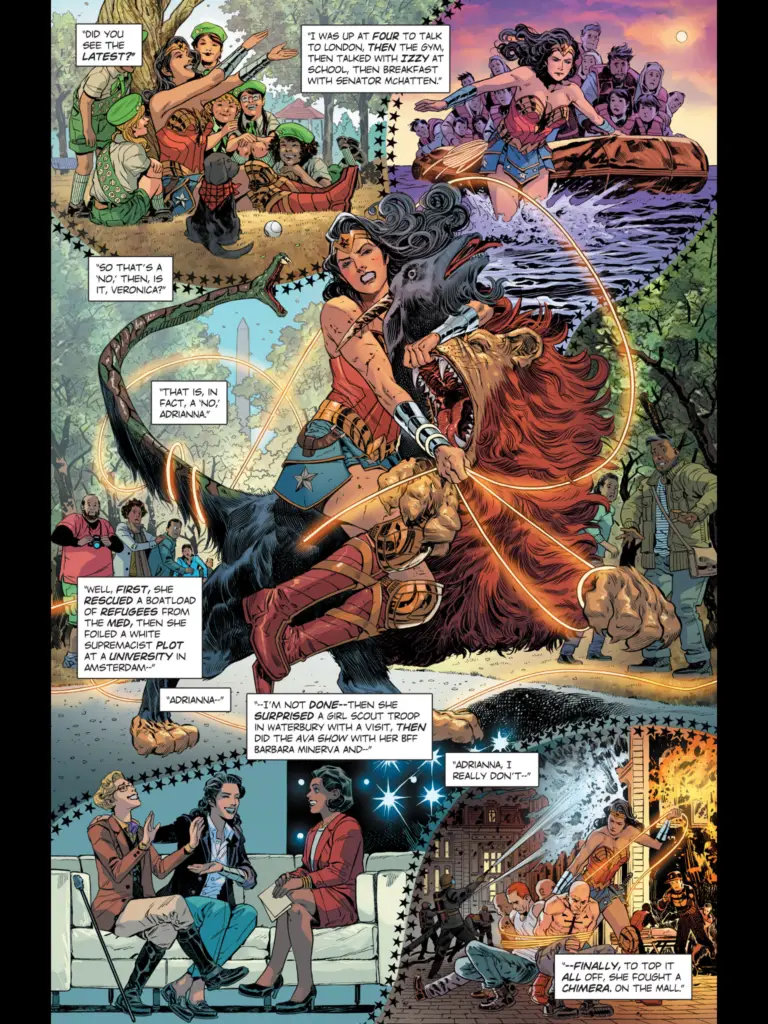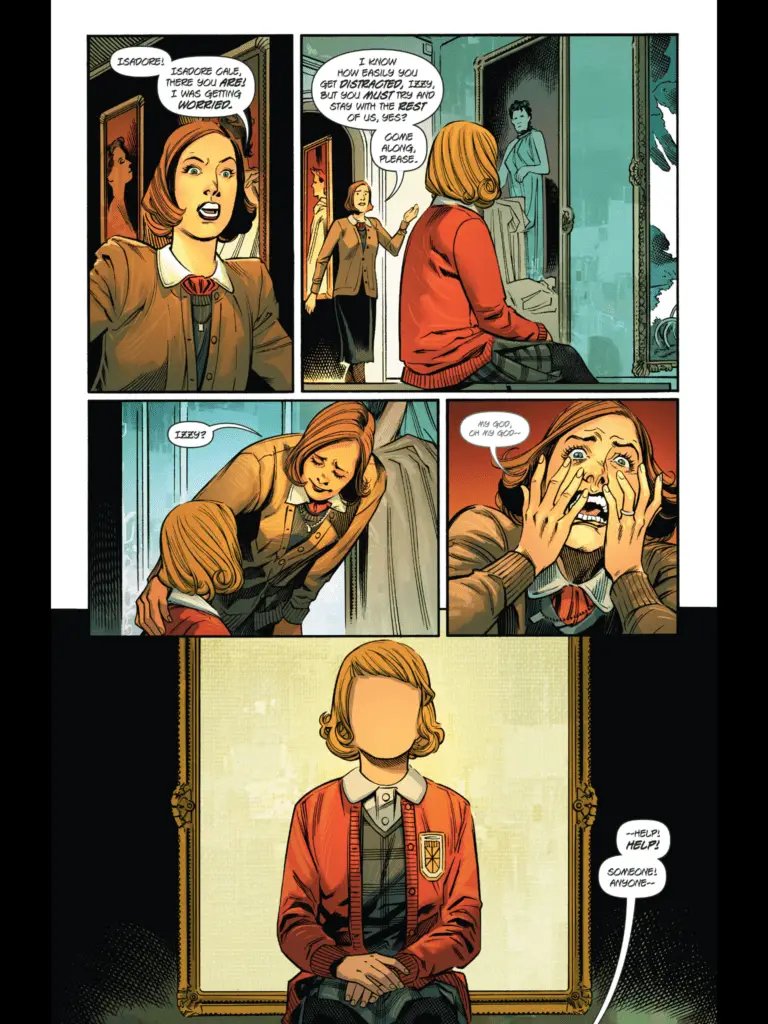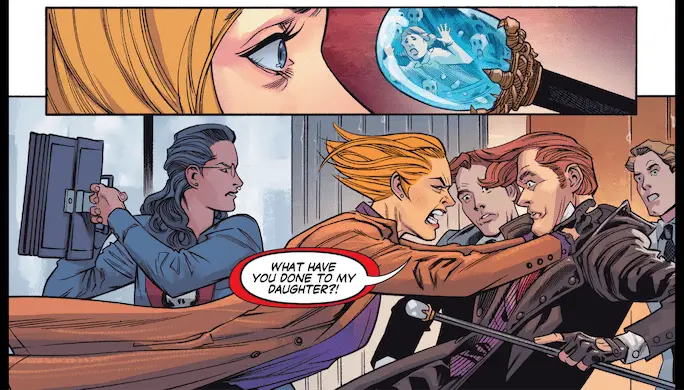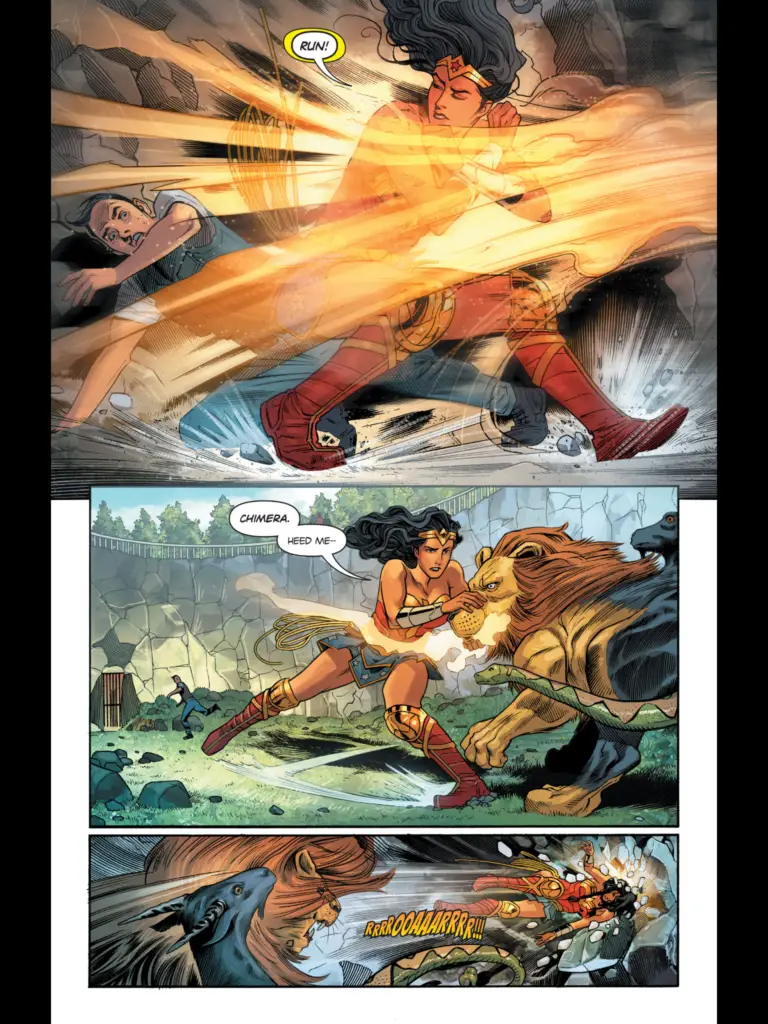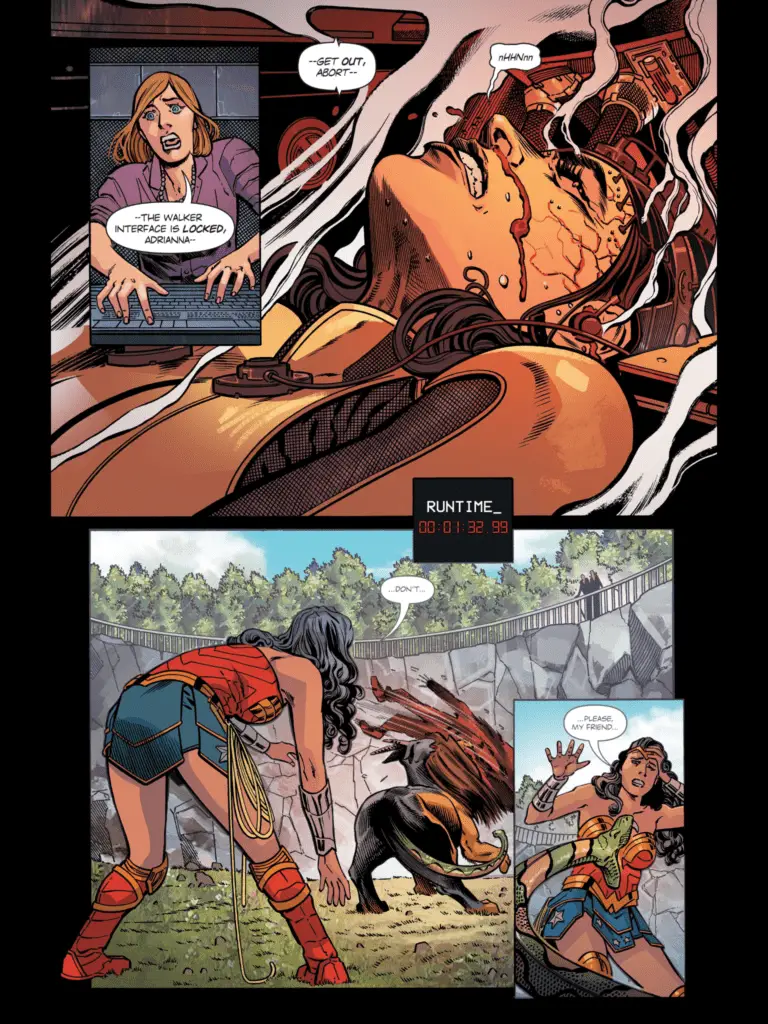Wonder Woman issue #16 kicks off the new arc, “Godwatch”, with a classic Villain Episode, tracing the turn-to-villainy for recurring Wonder Woman enemy Veronica Cale. In the ‘present’ timeline that is covered in the odd-numbered issues of the series, Cale is a full-blown supervillain whose mercenary henchmen have killed many of Diana’s human allies and is closing in on the rest of them. When she is introduced here in the ‘past’, however, she is just the normal head of a technology and manufacturing corporation, spending her time researching new technologies for profit and schmoozing politicians (Insert your own “So, she’s already a villain then” joke here). This story bridges the gap between the two different timelines being followed in this series, and begins to explain just what it is that Cale is after.
In contrast to the way they handled Diana’s sidelining in the “The Truth” arc—where the shifting focus of the book to Steve Trevor as The Hero really bungled handling Diana’s status as the main character—this issue manages to keep Diana in the story by having Veronica and Adrianna Anderson (The future Dr. Cyber) discuss her in their morning meeting. We are now six months after Diana’s appearance in the “Year One” arc, and in that time Wonder Woman has become a worldwide do-gooder and international celebrity. She is going on talk shows, visiting Girl Scout troops, rescuing refugees, fighting a Chimera, the works. In the midst of this, forced to hear the masses and media fawn over Diana, is Cale, whose cynical outlook on love and life views Diana’s message of peace as an outright lie.
Veronica is drawn into the story itself by the gods Deimos and Phobos, who want her to use her technology to steal the secret of Themyscira’s location from Diana’s mind. They have already tried themselves, but have come up empty-handed, and they think that whatever is blocking their god-abilities might not work so well against mortal technology. So, in the true spirit of beings whose names translate to “Dread” and “Fear”, they steal the face of Veronica’s daughter, imprisoning her inside a crystal, and threaten to have her devoured by spirits in Tartarus for eternity if Cale does not do what they ask.
Under that kind of threat, Cale reluctantly goes along, and her best friend Adrianna uses their still-experimental Cyberwalker technology to uplink with Wonder Woman’s mind to try to pry out the location of her home island. Unfortunately for…well, pretty much everybody….the entire event explodes into unexpected mythological violence and Adrianna winds up somewhat worse for wear.
In one fell encounter, Adrianna Anderson is turned into the virtual being that will become Dr. Cyber and Veronica Cale gains a deeply personal enmity against the Greek pantheon and Wonder Woman. From the end of this issue, their evolution into Comicbook Villains is all too easy to trace.
This issue provides a much needed fleshing-out of both Veronica Cale and Dr. Cyber’s characters, which have not been very deeply explored in the ‘present’ of the series. Because so much of Wonder Woman’s history has been thrown into doubt in the “The Lies” and “The Truth” arcs, all the past comic encounters with these characters might not have happened, so this adventure gives us our first glimpse of why they hate Wonder Woman, what their backgrounds are and where their motivations come from. It also does not just say “They’re evil”.
Veronica Cale, though cynical and nihilistic as befits a jaded billionaire CEO, is very much a caring mother, and her opening dialogue at the start of the issue shows that before she begins her day of meetings with senators, she takes the time to talk with her daughter at school. She and Adrianna have a very deep friendship, with Adrianna taking the risk of using the Cyberwalker system so that Veronica will still be around to care for her daughter in the event that things go wrong. When they are confronted by the gods who have stolen Izzy, though they do not know that they are gods just yet, their immediate reaction is not to cower or beg or dismiss what is happening, but to immediately attack. Adrianna appears to just be a research scientist, but as Veronica grabs them by the throat Adrianna has raised her own briefcase to smack them herself.
Even the gods look surprised.
The actual confrontation with Wonder Woman is a tragedy no matter which way you look at it. The situation is spurred by Deimos and Phobos agitating the Chimera that had been mentioned earlier in the story, and which is now being kept at the National Zoo. They toss a hapless zoo worker into its pit as bait, and true to form Wonder Woman shows up to save him.
I love the topmost panel of her save, as she blocks the fire with her crossed bracers, because this is a standard Wonder Woman depiction in a non-standard situation. Normally she is shown blocking bullets or straight-line magic, but since the bracers themselves are magic there is no reason they could not likewise stop area attacks like a plume of fire. Under the rules of normal physics it does not make sense, but under the rules of a comic book and the magic of Olympus, it is a logical extension of what they have already been shown to do. The second panel, though, is where Wonder Woman is Wonder Woman: She talks to the Chimera. She does not just start punching it, she tries to get it to stand down peaceably and figure out what is happening.
Even after Adrianna has attacked Wonder Woman with the Cyber platform and the Chimera turns against her, clearly having realized something about how it is being manipulated, Wonder Woman still tries to get the Chimera to halt its attack. Maybe it is that their mind-connection has shown her that Adrianna is being forced into this situation, or maybe it is is just her innate pure goodness, but either way, Wonder Woman still pleads for the life of her own attacker. Because that is the essence of who she is: She does not want to beat anybody, she wants to create a situation where nobody needs to be beaten at all.
This issue, unlike the “The Truth” arc, manages to keep Wonder Woman as an integral part of the events even though she is not the main character of this specific story. It expands on the characterization and motivation of Veronica Cale and Dr. Cyber, and lays the groundwork for the upcoming collision between the characters in the present timeframe. All in all, it captures the feel and integrity of a Wonder Woman story.
Images courtesy of DC Comics.
Wonder Woman #16
Writer: Greg Rucka
Pencils: Bilquis Evely
Colorist: Romulo Fajardo, Jr.
Cover: Evely & Fajardo, Jr.


